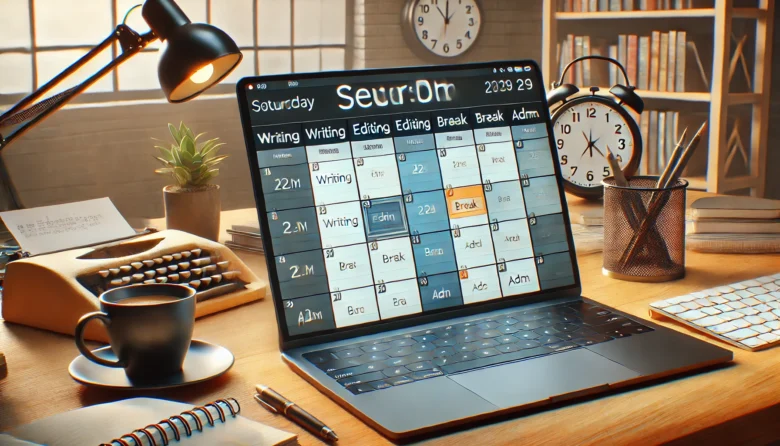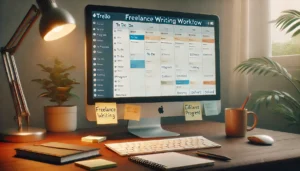As a freelance writer, how you structure your workday can make the difference between writing two articles or struggling to finish one. Unlike traditional jobs, freelancers have the freedom—and the challenge—of creating their own schedule. That freedom can lead to chaos… or to incredible productivity.
In this article, you’ll learn how to structure your day to maximize focus, minimize distractions, and get more writing done without burning out.
Why Structure Matters for Freelancers
When you control your own time, it’s easy to:
- Oversleep
- Start work late
- Jump from task to task
- End the day wondering where the time went
A well-structured day helps you:
- Focus deeply on writing
- Avoid decision fatigue
- Balance admin tasks with creative work
- Maintain energy levels throughout the day
Step 1: Know Your Energy Rhythms
Everyone has natural highs and lows during the day. Your first step is to figure out:
- When are you most focused?
- When do you feel tired or distracted?
- When do you get bursts of creativity?
Try this:
- Track your energy every hour for one week
- Rate it from 1 (tired) to 5 (energized)
- Use that data to plan your most important work for peak hours
Step 2: Use a Morning Kickoff Routine
Start your day with intention—not with your phone. A 20–30 minute routine helps signal to your brain that it’s time to work.
Ideas for a productive morning routine:
- Drink water and move your body
- Review your goals or to-do list
- Read a short motivational quote or journal
- Plan the top 3 things you must complete today
Avoid checking emails or social media first thing—your brain needs to warm up before external noise hits.
Step 3: Set Themed Work Blocks
Instead of multitasking all day, divide your workday into blocks of time focused on one type of task.
Here’s an example for freelance writers:
| Time | Task |
|---|---|
| 8:30–9:00 | Morning review & planning |
| 9:00–11:00 | Deep writing session (client work) |
| 11:00–11:30 | Short break + movement |
| 11:30–12:30 | Writing session 2 (blog or personal project) |
| 12:30–1:30 | Lunch and mental reset |
| 1:30–2:30 | Editing + proofreading |
| 2:30–3:00 | Admin (emails, pitches, invoices) |
| 3:00–3:30 | Wrap-up + tomorrow planning |
Tip: Stick to each block. Don’t answer emails during writing time. Protect your flow.
Step 4: Build in Micro Breaks
Breaks are not a luxury—they’re part of the productivity system.
Try:
- 5-minute breaks every 25–30 minutes
- 15-minute break after 2 focused hours
- Full 30–60-minute lunch away from your desk
Use breaks to:
- Stretch
- Walk
- Meditate
- Do nothing (seriously)
You’ll return more refreshed and creative.
Step 5: Limit Decision-Making During the Day
Save your mental energy for writing—not for wondering what to work on next.
Here’s how:
- Plan tomorrow’s tasks the night before
- Use the same templates and checklists
- Batch similar tasks together (write 3 intros, then 3 conclusions, etc.)
- Have a fixed end-of-day routine
Decision fatigue drains focus—structure helps avoid it.
Step 6: Define Your “End of Workday” Ritual
Freelancers often blur the line between work and personal life. Having an end-of-day ritual creates separation and reduces mental load.
Some ideas:
- Check off your to-do list
- Set priorities for tomorrow
- Clean up your workspace
- Close all tabs and shut your laptop
- Walk outside, listen to music, or cook a meal
When your day has a clear end, your brain can rest—and show up better tomorrow.
Step 7: Protect Your Deep Work Hours
Your most focused hours should be sacred. During this time:
- Silence your phone
- Use a website blocker
- Let family or housemates know you’re unavailable
- Put on noise-canceling headphones or background music
Even just 2–3 hours of deep work a day can double your writing output.
Step 8: Adjust and Reflect Weekly
Your first schedule won’t be perfect—and that’s okay. Set a time once a week to ask:
- What worked well this week?
- What dragged me down?
- Where did I waste time?
- What should I try differently next week?
Continuous improvement is the secret to sustainable productivity.
Final Thoughts: Build a Day That Works for You
There’s no one-size-fits-all workday. The best structure is the one that matches your energy, your goals, and your lifestyle.
Start with the basic blocks. Keep it simple. Then evolve your schedule week by week. You’ll soon find a rhythm where productivity flows naturally—and writing becomes more enjoyable than ever.



